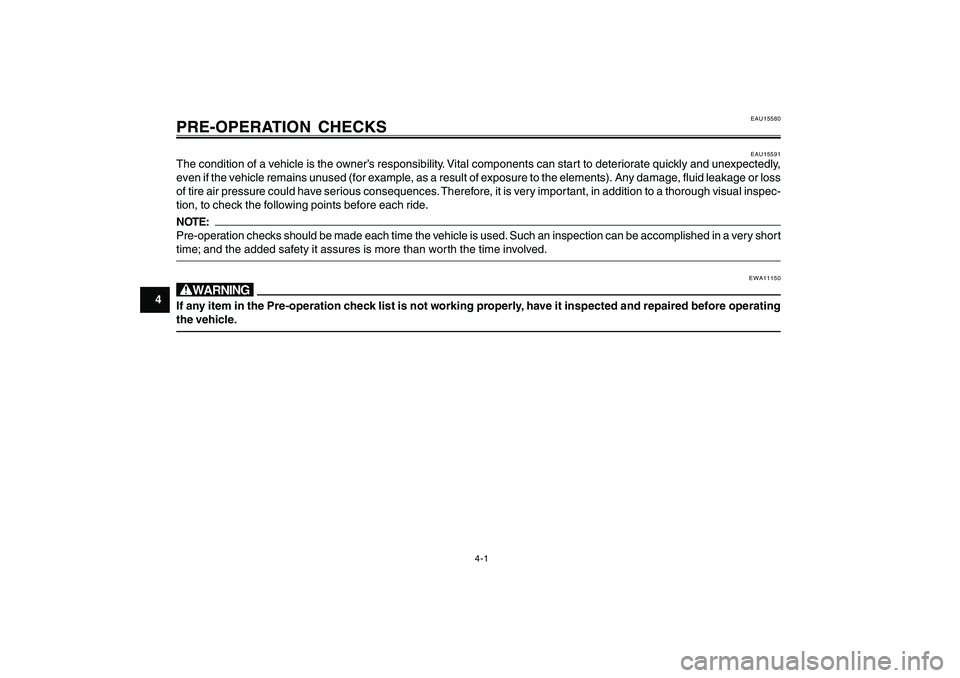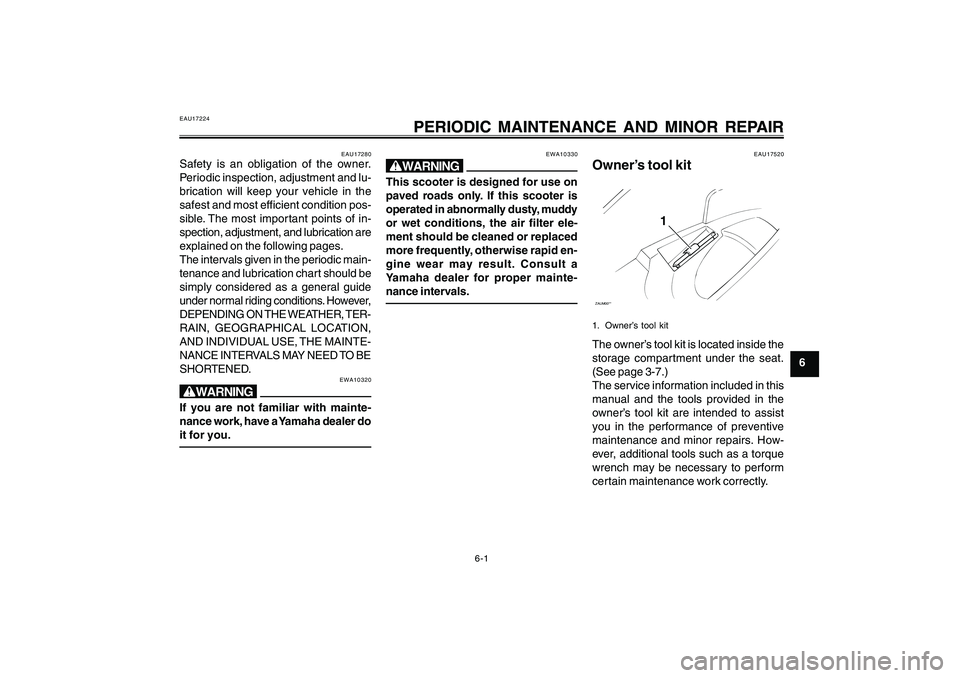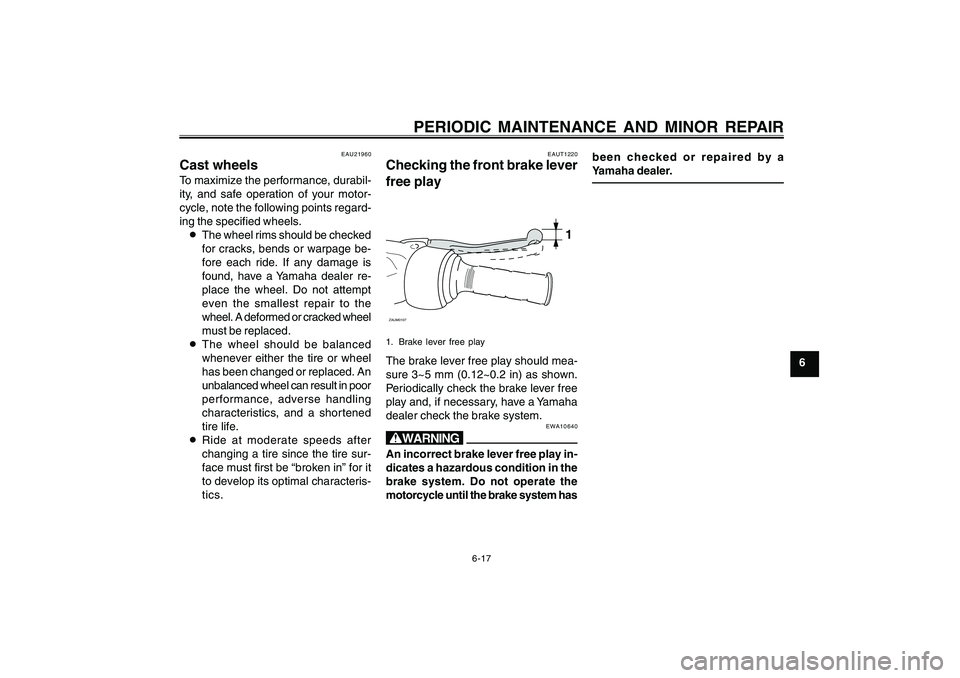2000 YAMAHA CYGNUS 125 air condition
[x] Cancel search: air conditionPage 28 of 76

4-1
1
2
3
4
5
6
7
8
9
PRE-OPERATION CHECKS
EAU15591
The condition of a vehicle is the owner’s responsibility. Vital components can start to deteriorate quickly and unexpectedly,
even if the vehicle remains unused (for example, as a result of exposure to the elements). Any damage, fluid leakage or loss
of tire air pressure could have serious consequences. Therefore, it is very important, in addition to a thorough visual inspec-
tion, to check the following points before each ride.NOTE:
Pre-operation checks should be made each time the vehicle is used. Such an inspection can be accomplished in a very short
time; and the added safety it assures is more than worth the time involved.
EWA11150
wIf any item in the Pre-operation check list is not working properly, have it inspected and repaired before operating
the vehicle.
EAU15580
PRE-OPERATION CHECKS
5ML-F8199-E0ch4.pmd2003/12/12, 16:03 1
Page 29 of 76

4-2
1
2
3
4
5
6
7
8
9
PRE-OPERATION CHECKS
EAU15602
Pre-operation check list
ITEM CHECKS PAGE
Fuel Check fuel level in fuel tank.
Refuel if necessary.
Check fuel line for leakage.3-6
Engine oil Check oil level in engine.
If necessary, add recommended oil to specified level.
Check vehicle for oil leakage.6-8
Final transmission oil Check vehicle for oil leakage. 6-10
Front brake Check operation.
If soft or spongy, have Yamaha dealer bleed hydraulic system.
Check brake pads for wear.
Replace if necessary.
Check fluid level in reservoir.
If necessary, add recommended brake fluid to specified level.
Check hydraulic system for leakage.6-18, 6-19
Rear brake Check operation.
Lubricate cable if necessary.
Check lever free play.
Adjust if necessary.6-18, 6-19
Throttle grip Make sure that operation is smooth.
Check cable free play.
If necessary, have Yamaha dealer adjust cable free play and lubricate cable and
grip housing.6-14, 6-21
Wheels and tires Check for damage.
Check tire condition and tread depth.
Check air pressure.
Correct if necessary.6-15, 6-17
Brake levers Make sure that operation is smooth.
Lubricate lever pivoting points if necessary.6-21
5ML-F8199-E0ch4.pmd2003/12/12, 16:03 2
Page 35 of 76

6-1
1
2
3
4
5
6
7
8
9
PERIODIC MAINTENANCE AND MINOR REPAIR
EAU17224
PERIODIC MAINTENANCE AND MINOR REPAIR
EAU17280
Safety is an obligation of the owner.
Periodic inspection, adjustment and lu-
brication will keep your vehicle in the
safest and most efficient condition pos-
sible. The most important points of in-
spection, adjustment, and lubrication are
explained on the following pages.
The intervals given in the periodic main-
tenance and lubrication chart should be
simply considered as a general guide
under normal riding conditions. However,
DEPENDING ON THE WEATHER, TER-
RAIN, GEOGRAPHICAL LOCATION,
AND INDIVIDUAL USE, THE MAINTE-
NANCE INTERVALS MAY NEED TO BE
SHORTENED.
EWA10320
wIf you are not familiar with mainte-
nance work, have a Yamaha dealer do
it for you.
EWA10330
wThis scooter is designed for use on
paved roads only. If this scooter is
operated in abnormally dusty, muddy
or wet conditions, the air filter ele-
ment should be cleaned or replaced
more frequently, otherwise rapid en-
gine wear may result. Consult a
Yamaha dealer for proper mainte-
nance intervals.
EAU17520
Owner’s tool kitZAUM00**
1
1. Owner’s tool kitThe owner’s tool kit is located inside the
storage compartment under the seat.
(See page 3-7.)
The service information included in this
manual and the tools provided in the
owner’s tool kit are intended to assist
you in the performance of preventive
maintenance and minor repairs. How-
ever, additional tools such as a torque
wrench may be necessary to perform
certain maintenance work correctly.
5ML-F8199-E0ch6re.pmd2003/12/12, 16:04 1
Page 37 of 76

6-3
1
2
3
4
5
6
7
8
9
PERIODIC MAINTENANCE AND MINOR REPAIR
EAU17710
Periodic maintenance and lubrication chartNOTE:
8 88 8
8The annual checks must be performed every year, except if a kilometer-based maintenance is performed in-
stead.
8From 30000 km, repeat the maintenance intervals starting from 6000 km.
8Items marked with an asterisk should be performed by a Yamaha dealer as they require special tools, data and technical
skills.NO. ITEM CHECK OR MAINTENANCE JOBODOMETER READING (�u1,000 km)
ANNUAL
CHECK
1 6 12 18 24
1
*Fuel line Check fuel hoses and vacuum hose for cracks or damage.�—�—�—�— �—
2 Spark plug Check condition.
Clean and regap.�—�—
Replace.�—�—
3*Valves Check valve clearance.
Adjust.�—�—�—�—
4 Air filter element Clean.�—�—
Replace.�—�—
5V-belt case air filter
element Clean.�—�—�—�—
6*Front brake Check operation, fluid level and vehicle for fluid leakage.�—�—�—�—�— �—
Replace brake pads. Whenever worn to the limit
7*Rear brake Check operation and adjust brake lever free play.�—�—�—�—�— �—
Replace brake shoes. Whenever worn to the limit
8*Brake hose Check for cracks or damage.�—�—�—�— �—
Replace. Every 4 years
5ML-F8199-E0ch6re.pmd2003/12/12, 16:04 3
Page 41 of 76

6-7
1
2
3
4
5
6
7
8
9
PERIODIC MAINTENANCE AND MINOR REPAIR
EAUT1170
Checking the spark plugThe spark plug is an important engine
component, which is easy to check.
Since heat and deposits will cause any
spark plug to slowly erode, the spark
plug should be removed and checked in
accordance with the periodic mainte-
nance and lubrication char t. In addition,
the condition of the spark plug can re-
veal the condition of the engine.
To remove the spark plug
1. Remove panel C. (See page 6-6.)
2. Remove the spark plug cap.
3. Remove the spark plug as shown,
with the spark plug wrench included
in the owner’s tool kit.ZAUM00**1
1. Spark plug wrench
To check the spark plug
1. Check that the porcelain insulator
around the center electrode of the
spark plug is a medium-to-light tan
(the ideal color when the vehicle is
ridden normally).NOTE:
If the spark plug shows a distinctly dif-
ferent color, the engine could be defec-
tive. Do not attempt to diagnose such
problems yourself. Instead, have a
Yamaha dealer check the vehicle.2. Check the spark plug for electrode
erosion and excessive carbon or
other deposits, and replace it if nec-
essary.
Specified spark plug:
CR7E (NGK)
To install the spark plug
1. Measure the spark plug gap with a
wire thickness gauge and, if nec-
essary, adjust the gap to specifi-
cation.
ZAUM00**
12(×4)
1. Panel B
2. ScrewTo install the panel
Place the panel in the original position,
and then install the screws.
5ML-F8199-E0ch6re.pmd2003/12/12, 16:04 7
Page 49 of 76

6-15
1
2
3
4
5
6
7
8
9
PERIODIC MAINTENANCE AND MINOR REPAIR
EAU33600
TiresTo maximize the performance, durabil-
ity, and safe operation of your vehicle,
note the following points regarding the
specified tires.
Tire air pressure
The tire air pressure should be checked
and, if necessary, adjusted before each
ride.
EWA10500
w8 88 8
8The tire air pressure must be
checked and adjusted on cold
tires (i.e., when the temperature
of the tires equals the ambient
temperature).
8 88 8
8The tire air pressure must be
adjusted in accordance with the
riding speed and with the total
weight of rider, passenger, cargo,
and accessories approved for this
model.
Tire air pressure (measured on cold
tires):
0~90 kg (0~198 lb):
Front:
175 kPa (26 psi) (1.75 kgf/cm
2)
Rear:
200 kPa (29 psi) (2.0 kgf/cm2)
90~170 kg (198~419 lb) to maxi-
mum load:
Front:
200 kPa (29 psi) (2.0 kgf/cm2)
Rear:
225 kPa (33 psi) (2.25 kgf/cm2)
Maximum load*:
170 kg (374 lb)
* Total weight of rider, passenger,
cargo and accessories
EWA11200
wBecause loading has an enormous
impact on the handling, braking, per-
formance and safety characteristics
of your vehicle, you should keep the
following precautions in mind.
8 88 8
8NEVER OVERLOAD THE VE-
HICLE! Operation of an over-
loaded motorcycle may result in
tire damage, loss of control, orsevere injury. Make sure that the
total weight of rider, passenger,
cargo, and accessories does not
exceed the specified maximum
load for the vehicle.
8 88 8
8Do not carry along loosely
packed items, which can shift
during a ride.
Securely pack the heaviest items
close to the center of the vehicle
and distribute the weight evenly
on both sides.
8 88 8
8Adjust the tire air pressure with
regard to the load.
Check the tire condition and air
pressure before each ride.
5ML-F8199-E0ch6re.pmd2003/12/12, 16:04 15
Page 51 of 76

6-17
1
2
3
4
5
6
7
8
9
PERIODIC MAINTENANCE AND MINOR REPAIR
EAU21960
Cast wheelsTo maximize the performance, durabil-
ity, and safe operation of your motor-
cycle, note the following points regard-
ing the specified wheels.
8The wheel rims should be checked
for cracks, bends or warpage be-
fore each ride. If any damage is
found, have a Yamaha dealer re-
place the wheel. Do not attempt
even the smallest repair to the
wheel. A deformed or cracked wheel
must be replaced.
8The wheel should be balanced
whenever either the tire or wheel
has been changed or replaced. An
unbalanced wheel can result in poor
performance, adverse handling
characteristics, and a shortened
tire life.
8Ride at moderate speeds after
changing a tire since the tire sur-
face must first be “broken in” for it
to develop its optimal characteris-
tics.
EAUT1220
Checking the front brake lever
free play
1
ZAUM01071. Brake lever free playThe brake lever free play should mea-
sure 3~5 mm (0.12~0.2 in) as shown.
Periodically check the brake lever free
play and, if necessary, have a Yamaha
dealer check the brake system.
EWA10640
wAn incorrect brake lever free play in-
dicates a hazardous condition in the
brake system. Do not operate the
motorcycle until the brake system hasbeen checked or repaired by a
Yamaha dealer.
5ML-F8199-E0ch6re.pmd2003/12/12, 16:04 17
Page 54 of 76

6-20
1
2
3
4
5
6
7
8
9
PERIODIC MAINTENANCE AND MINOR REPAIR8As the brake pads wear, it is nor-
mal for the brake fluid level to
gradually go down. However, if the
brake fluid level goes down sud-
denly, have a Yamaha dealer check
the cause.
EAU22720
Changing the brake fluidHave a Yamaha dealer change the brake
fluid at the intervals specified in the
NOTE after the periodic maintenance
and lubrication chart. In addition, have
the oil seals of the brake master cylin-
der and caliper as well as the brake hose
replaced at the intervals listed below or
whenever they are damaged or leaking.
8Oil seals: Replace every two years.
8Brake hose: Replace every four
years.
EAU23100
Checking and lubricating the
cablesThe operation of all control cables and
the condition of the cables should be
checked before each ride, and the
cables and cable ends should be lubri-
cated if necessary. If a cable is dam-
aged or does not move smoothly, have
a Yamaha dealer check or replace it.
Recommended lubricant:
Engine oil
EWA10720
wDamage to the outer sheath may in-
terfere with proper cable operation
and will cause the inner cable to rust.
Replace a damaged cable as soon as
possible to prevent unsafe condi-
tions.
5ML-F8199-E0ch6re.pmd2003/12/12, 16:04 20